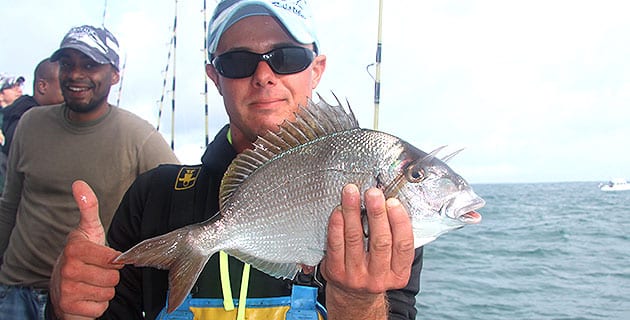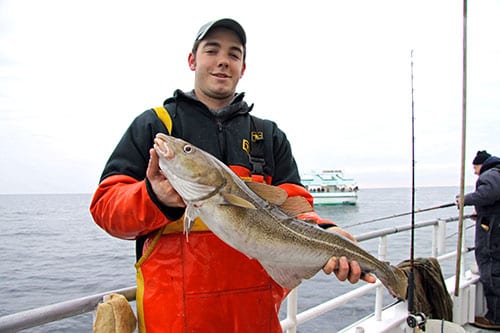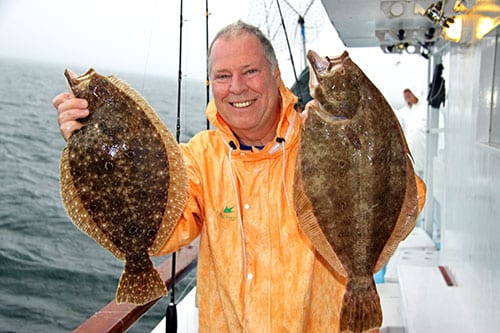
By Tom Schlichter
With the Northeast in the depths of one of the windiest winters in decades, opportunities to get out and sample a little cod fishing have been even less reliable than in most years. That, however, has left plenty of time to debate the merits of fishing questions that get bounced around at the winter shows, fishing flea markets or even over a cold one in front of the fire place. One debate that makes the rounds on a consistent basis has to do with which spot is best to fish from on a party boat. It’s the kind of question that seems easy to answer at first but the deeper you dig the more complicated it becomes. In fact, based on any particular set of variables, arguments can be made for the stern, the bow or even amidships, so let’s take a closer look.
IT ALL DEPENDS

Of course, the snide mate in any fishing discussion will immediately quip that the best spot to be on any boat is the one where the fish are coming over the rail. Be that as it may, the answer to this question largely depends on the likely method of fishing. Party boats employ several general techniques including anchoring over open bottom, anchoring over wrecks or structure, anchoring and chumming, drifting, and drifting with the aid of chum. Let’s examine each of these methods starting with simplest: anchoring over open bottom.
Porgy fishing is a good example of this procedure. Essentially, the skipper locates a piece of bottom known to harbor the target species, sets the anchor, and signals for fishing to commence. With this method each patron has a roughly equal chance of getting a bite because the fish are scattered in no particular pattern beneath the boat. Fishing on the down-tide side will probably reduce the chance of crossing lines and thus, is generally the preferred place to set up shop.
Wreck or structure fishing differs from open bottom anchoring in that the boat is intentionally positioned directly above a specific object or break in the bottom contour. A ledge, hump, sunken ship, mussel bed or similar distortion are among the usual targets, especially when fishing for blackfish, sea bass and cod. In this instance, amidships is a safe bet as the skipper tries to align his vessel with the underwater target. Ideally, the entire boat settles directly above prime bottom but changes in tide, current, strength or wind direction may swing the vessel partially or even entirely off the structure. When this happens, those anglers still situated above the target will continue to catch while those now over open water may find reduced action. Fishing from amidships increases your chances of staying above selected bottom as the boat shifts through the course of the day.

Drifting requires more consideration and greater individual skill to be successful. As with anchoring, most positions along the rail have a fairly equal chance of hooking up. Those at the head of the drift, however, get first crack at the fish. This slight advantage is somewhat negated by lines drifting under the boat which results in a loss of control and sensitivity. Anglers fishing the backside of the drift will find the fishing less exhausting as their lines should play straight out, resulting in greater feel, less frequent tangles and easier retrieves. Experts might prefer to be up-current/upwind on the drift but novice anglers will probably find the fishing more pleasurable on the down-current/downwind side. To be fair, most skippers alternate during the day so that all patrons get the opportunity to fish both ways.
The addition of chum to any method of fishing radically alters productivity around the rail. First of all, chumming increases everyone’s chances. It does not, however, increase chances equally. That’s because, in any form, chum drifts down-current from the boat. From a fish’s perspective, then, the food source is certainly located up-current – so most fish swim against the flow as they follow the slick to its source making those baits located down-current the first encountered. From an anchored boat the stern is certainly a good choice. On a drifting vessel, the obvious choice would be the down-current side.
In those instances where wind and tide collide, chum may move in seemingly odd directions, causing a shift in productivity throughout the ship. Be assured, however, that no matter how things appear, chum always drifts with the current. One aspect of chumming that should never be overlooked is that chum ultimately increases everybody’s chances for success. Thus, if one section of the boat seems to be getting the best of the action, keep in mind that you’re probably still doing better than you might have without its aid.









